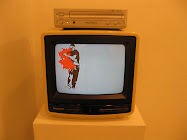Femininity: Many Reflections (Salli Babbitt)
LIT. FIG. (L. Brandon Krall)
Deborah Colton Gallery
through June 30
Deborah Colton’s austere third-floor gallery vibrates with energy this month as two artists take on femininity and language with a highly subjective eye. As more art businesses open in the warehouse on Summer Street, Colton has become the axis of a growing center next to David Addicks’ foundry. The two artists featured here demonstrate in turn a commitment to Houston’s talent, and projecting influence on the community with international artists relevant to our local trajectory.
Salli Babbitt has focused her sculpture on the flashpoint image of the Barbie doll for years, literalizing an American bipolar relationship with the action figure that has lasted through three generations. Her mutilations, humiliations and disfigurement don’t quite take the extra step of being gory, softening her critique of the forlorn idol. In rows across a canvas or wrapped around a cone in an ad-hoc altar Barbie’s are alternately red, gray or glittery, gold and other colors creep onto other paintings as well. Wall sconces are a favorite of the artist; The Three Graces, Pompeian Orgy and others occupy the well-lit gallery overlooking David Addicks’ gigantic Beatles statues in the parking lot next door. Too awkward to be Pop, too minimal to be teenage angst, Babbitt charts her own awkward course working with molded plastic females. Babbitt has also included disjointed abstract paintings, some with scrawled handwritten letters scratched into wet paint. Owing much to her charitable work with Multiple Sclerosis patients and physically disadvantaged persons, these works are a labor of love for the artist but take away from the show overall.
Half of an all-out assault on Houston by New Yorker L. Brandon Krall, LIT. FIG. dovetails with QUA, concurrently at G Gallery on 11th Street in the Heights. Krall has been in town working with Deborah Colton many times, including the significant exhibit WORD last September. Her solo work this time around also demonstrates the artist’s interest in the enigmas of wordplay. Opening with a series of short videos from several dinner parties Krall threw in her apartment, artists act out popular idioms with everyday items; walking on eggshells, writing “IT” on someone’s face and wearing too many hats. These videos are part of an ongoing series improvised in many locations. The straightforward camerawork makes for a screen test atmosphere- like Warhol’s but a bit more fun for the audience. Among others, sculptor William Stone, literary critic Fillipo LaPorta and Valeria D’Andrea sit in front of a fixed spot while a party goes on all around them. Mostly known by the din on the soundtrack or a figure darting in and out, the relaxed atmosphere transferred well to the video, and the context for the rest of the exhibit is laid. After a short physical demonstration the riddle is spelled out on the screen; “starting with a blank slate”; “poring over a book”. Props are displayed around the room, absurd collections and juxtapositions. As part of the collection GLYPT, from the Greek for ‘carve’, a glass vitrine contains metal readymades engraved in a delicate script with the artist’s figurative literalities in Latin and English. Working with The Art Guys, Jack and Mike, Krall ambitiously constructed a large wheel to take for a hike- an old wagon wheel pivoting on two Live Oak branches. The version here, Wheel for Walking in Texas, is the sixth in a series. The artist has made and used several of these contraptions to occupy herself on walks through the city; a smaller one is included in QUA, where the wheel’s relation to the I-Ching is more pronounced. As distinct halves of an artist’s output the two exhibits are coherent alone, but they are more illustrative of a creative process when taken together.






















